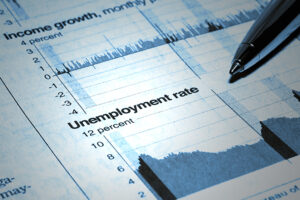The most important events of the week for the markets: GDP and PCE
In the coming week, the focus of macroeconomic attention will be on Wednesday's publication of minutes from the last meeting Federal Reserve and Thursday's revised estimate of US GDP for the fourth quarter, as well as the PCE inflation reading.
WHAT COULD MOVE THE MARKETS IN THE NEXT WEEK?
Our subjective selection of potentially market-moving economic events for the business week starting February 20:
Monday February 20
-
- President's Day
Wednesday, February 22
-
- Minutes of the last Fed meeting
The market's reaction to the quarter-point interest rate hike by the Federal Reserve on Feb. 1 revealed a rift. Investors and the Fed appear to be at odds over the direction interest rates may go this year, with the central bank committing to "stay the course" in its fight against inflation and markets betting the Fed will ease its stance. Although recent data on CPI inflation and PPI pulled market expectations closer to Fed communication.
Fed Chairman Jay Powell at a press conference on Feb. 1, Powell insisted more rate hikes were coming and said the Fed had no plans to cut rates this year. However, his lack of a firm answer to direct questions about market expectations for rate cuts deepened the gap between market valuations of rates and the Fed's economic forecasts.
Since that meeting and the press conference, several Fed officials have countered the market's dovish narrative, promising that rates will stay higher for longer. Minutes from the meeting should provide a deeper insight into policy makers' thinking on inflation and how long they expect rates to stay at current levels. However, it is worth remembering that the meeting took place before the release of the US data and employment report, which showed that the US economy unexpectedly added 517 jobs in January. The key question that the minutes can answer is whether Fed officials stand by their December dot plot, which forecast the rate at the end of 000 at 2023%.
Thursday, February 23
-
- US GDP IN QXNUMX
Although the Fed raised its benchmark interest rate to the range of 4,5%-4,75%, the US economy is holding up quite well, with strong growth in QXNUMX and QXNUMX last year after a weak first half.
The first estimate of GDP for the fourth quarter last month showed growth of 2,9%, above economists' expectations of 2,5%. In the third quarter, the increase amounted to 3,2%. Growth in consumer spending was a bit disappointing at 2,1%, down from 2,3% in QXNUMX, though hardly surprising given retail sales contracted in November and December as shoppers stocked up before the holiday season. Spending may pick up in January as personal spending and income figures come out soon.'
Friday, February 24
-
- Core US PCE Price Index (January)
The Fed's preferred measure of inflation, consumer price index (PCE), fell to 4,4% in December from 5,2% in September. With the index falling to its lowest level since October 2021, the "disinflation" narrative has fueled markets and fueled speculation that the Fed may cut interest rates before the end of 2023.
A further decline in January's core PCE reading could help sustain the narrative of weakening price growth. Unfortunately for the stock market bulls, however, the strong employment report for January suggests that a sharp drop in core PCE is unlikely. The US economy unexpectedly added 517 jobs in January, shattering economists' forecasts of 000. Inflation could therefore remain relatively high, with prices potentially inflated by higher personal spending among working people.






















![Forex Club – Tax 9 – Settle tax on a foreign broker [Download the Application] Forex Club - Tax 9](https://forexclub.pl/wp-content/uploads/2024/02/Forex-Club-Podatek-9-184x120.jpg?v=1709046278)
![Trading View platform – solutions tailored to the needs of traders [Review] trading view review](https://forexclub.pl/wp-content/uploads/2024/03/trading-view-recenzja-184x120.jpg?v=1709558918)
![How to connect your FP Markets account to the Trading View platform [Guide] fp markets trading view](https://forexclub.pl/wp-content/uploads/2024/02/fp-markets-trading-view-184x120.jpg?v=1708677291)
![How to invest in ChatGPT and AI? Stocks and ETFs [Guide] how to invest in chatgpt and artificial intelligence](https://forexclub.pl/wp-content/uploads/2023/02/jak-inwestowac-w-chatgpt-i-sztuczna-inteligencje-184x120.jpg?v=1676364263)


![WeWork – the anatomy of the collapse of a company valued at $47 billion [WeWork, part II] wework bankruptcy story](https://forexclub.pl/wp-content/uploads/2024/04/wework-bankructwo-historia-184x120.jpg?v=1711729561)
![Adam Neumann – the man who screwed up Softbank [WeWork, part AND] adam neumann wework](https://forexclub.pl/wp-content/uploads/2024/04/adam-neumann-wework-184x120.jpg?v=1711728724)





![How to transfer shares to another brokerage office [Procedure description] how to transfer shares to another brokerage house](https://forexclub.pl/wp-content/uploads/2024/03/jak-przeniesc-akcje-do-innego-biura-maklerskiego-184x120.jpg?v=1709556924)

![The most common mistakes of a beginner trader - Mr Yogi [VIDEO] Scalping - The most common mistakes of a beginner trader - VIDEO](https://forexclub.pl/wp-content/uploads/2024/03/Scalping-Najczestsze-bledy-poczatkujacego-tradera-VIDEO-184x120.jpg?v=1711601376)
![Learning patience: No position is also a position - Mr Yogi [VIDEO] Scalping - Learning patience - No position is also a position - VIDEO](https://forexclub.pl/wp-content/uploads/2024/03/Scalping-Nauka-cierpliwosci-Brak-pozycji-to-tez-pozycja-VIDEO-184x120.jpg?v=1710999249)
![When to exit a position and how to minimize losses - Mr Yogi [VIDEO] Scalping - When to exit a position and how to minimize losses - VIDEO](https://forexclub.pl/wp-content/uploads/2024/03/Scalping-Kiedy-wyjsc-z-pozycji-i-jak-minimalizowac-straty-VIDEO-184x120.jpg?v=1710336731)

















